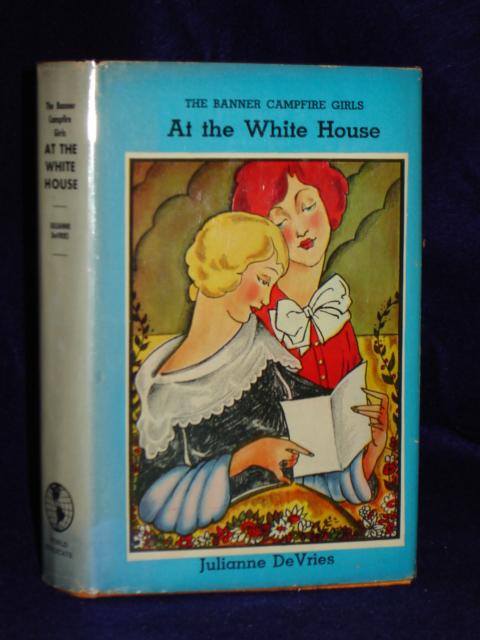Book Review: The Banner Campfire Girls at the White House by Julianne DeVries
Summer vacation has just started, and the high-spirited Camp Fire Girls of Wa-Wan-Da Council of Oakdale have already assaulted a federal agent. Fortunately, George Thompson, personal representative of the President of the United States, is in a forgiving mood. You see, that president has requested that the girls and their Guardian be his guests at the White House for a few months. Why, you might ask? That’s a secret!

This book is a little obscure, it seems. The title on the title page is “The Camp Fire Girls at the White House”, which seems to be the sixth book written in the series by Julianne DeVries (otherwise unknown) and may or may not be part of an overall Campfire Girls series going back to 1912. This volume was printed in 1935.
Our heroines are five of the twenty girls in the chapter. Mabel Chapman is chubby and a big eater, Lenore Rivers is a redhead who has her own car, Dolores Rodriguez is tall and more dignified than the other girls, Alice Blake is blonde and has a reputation for being boy-crazy, and Anita Brooks is the smallest and merry. They are led by the only a few years older Mrs. Florence Evans, repeatedly referred to as “young and attractive” by the narration, who is married to a lawyer.
These Camp Fire Girls have had several adventures before, including an around the world trip to plant new Camp Fire chapters, and unmasking a smuggling ring, the latter of which brought them to the attention of the Federal government. Based on their past performance, the president and his wife (never specifically identified as Franklin and Eleanor Roosevelt, but no details contradict this) believe the girls are the best people to spearhead a secret project.
It seems there’s new legislation in the pipeline, the Coe Bill, which will greatly improve the lives of the working poor. Details are sketchy, but we do know that it will require corporations to divert some of their profits from lining the pockets of the stockholders and corporate executives to not being as oppressive to the workers. This is why the Robinson Syndicate, led by one of the wealthiest businessmen in the country, is opposed to the bill and using their influence to try to keep the public ignorant of it.
To counter this, the president wants to enlist the Camp Fire organization to raise awareness of “the better things in life” among the public so that they will demand Congress make the reforms that the Coe Bill is about. And so our heroines find themselves living in the White House, and organizing plans for the effort to then distribute to the larger Camp Fire organization. (These plans are never actually detailed.)
The Robinson Syndicate knows that the Camp Fire Girls are somehow key to the passage of the Coe Bill, but not what the actual plan is. So they make some feeble attempts at getting rid of the young ladies, before Mr. Robinson finally resorts to coming to the White House and personally attempting to bribe our heroines into not doing whatever it is they’re supposed to be doing. It does not end well for him.
The Coe Bill passes, but the Robinson Syndicate still has one last feeble attempt to deal with the Camp Fire Girls…
A few months later, a flu epidemic temporarily closes Oakdale High School, just in time for the girls and their Guardian to be called into action again. It seems that notorious criminal Vincenzo Maricopa has escaped prison. He’s a master of disguise and has memorized the faces of all known federal agents, so it will be tricky to catch him. That is, of course, unless a small band of teenage girls is put at the forefront of the investigation!
The girls travel from Oakdale (which from earlier clues is in western Wisconsin or eastern Illinois) to Boise, Idaho, and then to San Francisco’s Chinatown in search of the criminal. (Apparently his main M.O. is labor agitation, but he does a lot of illegal stuff too.)
With Maricopa captured, it’s back to Oakdale for a quick coda that looks like it’s going to be another exciting case, but is just a misunderstanding.
Despite our heroines being in their late teens (boyfriends are mentioned but do not play any role in the plot), it’s clear that this book is aimed at prepubescent children. The political process is vastly simplified, gritty details are avoided, and save for one moment at the end, even the remotest possibility of danger to the girls is efficiently dealt with by competent adults. And at that point, five healthy teenagers swarming one man isn’t exactly a fair fight.
It’s somewhat nice to see a story with competent government agents when the plot isn’t about those characters.
A lovely bonkers premise is sadly undercut by subpar writing. The characters are one-note, neither learning or growing during the course of the story. The first half of the story completely misses the obvious potential for political satire or even just having an actual political viewpoint. The second half repeatedly defuses any mystery or tension that you might have expected from a chase after a dangerous criminal.
The result is rather like a roleplaying game for young children where the GM is worried about it being too hard so handholds the players all the way through.
Content note: Period ethnic stereotypes.
I’d like to see a much better book with the same premise.
Recommended primarily as a curiosity item, especially if you have ever been a member of the Camp Fire organization. https://campfire.org/about/

